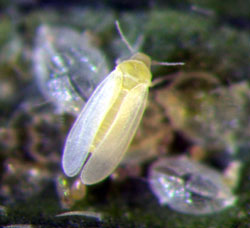By Hugh Smith
The silverleaf whitefly (Bemisia tabaci) transmits tomato yellow leaf curl virus in tomatoes. The pest also transmits three viruses to cucurbits, including squash vein yellowing virus, which causes watermelon vine decline. In addition to virus transmission and contamination, the silverleaf whitefly induces irregular ripening in tomato and the silverleafing in squash that gives it its common name.
Extended freezes during winter months can reduce whitefly populations and allow growers a reprieve from whitefly pressure in the spring season. In the absence of significant freeze events during the winter, whitefly numbers and viral inoculum can be high in spring crops.
POST-HARVEST CROP DESTRUCTION
Weeds that harbor
whitefly-transmitted viruses have been identified. However, the primary source
of whitefly viruses is probably crop hosts rather than weeds. The most
important thing growers can do to reduce whitefly-transmitted viruses is promptly
destroy all fields after final harvest.
Killing the crop with a material such as paraquat (Gramoxone) is an important first step, but treated fields can continue to produce new growth that can harbor whiteflies and virus. Crop destruction should include prompt disking in of vegetative material as soon as possible. Growers who plant new fields near last seasons’ residues will produce virus problems that they cannot spray their way out of.
METALIZED MULCH
Metalized plastic
mulches that repel whiteflies early in the season have demonstrated the ability
to reduce numbers of whitefly eggs and nymphs in tomato and to delay the onset
of virus. Field trials have not consistently shown a correlation between the
use of metalized mulches and increases in yield.
VIRUS-TOLERANT VARIETIES
The best tool
presently available to growers to manage tomato yellow leaf curl virusis the availability of varieties with
tolerance to the virus. Virus-tolerant tomato varieties can still be infected
with the virus, but higher virus pressure is needed to impact yield.
Many tomato growers plant a combination of virus-tolerant and virus-susceptible varieties because of preferred ripening and yield characteristics in some virus-susceptible varieties. Regardless of the pathogen resistance package in a given variety, growers should attempt to separate new plantings from older plantings spatially, since older crops may be a source of pests and disease. There are currently no commercial cucurbit varieties with tolerance to whitefly-transmitted viruses.
INSECTICIDE OPTIONS
Insecticides provide
protection against whitefly-transmitted viruses when whitefly numbers and viral
pressure are low or moderate. It has become increasingly clear in recent years
that insecticides alone cannot provide adequate protection when whitefly
numbers and virus are high.
Tomato and cucurbit crops should be treated at planting with one of the systemic neonicotinoid insecticides [Admire Pro, Platinum or Venom; mode of action (MoA) group 4A] or the closely related Sivanto Prime (MoA 4D). Plants can also be treated with the MoA group 28 systemic diamide insecticide Verimark (soil application) or Exirel (foliar application). Verimark and Exirel provide protection against leafminers and caterpillars that may be more useful after the crop has become established.
The insecticidal soap M-Pede can help reduce numbers of whitefly eggs and nymphs, and early-season virus incidence. Whitefly nymphs can be treated with the growth regulators Courier SC (MoA 16) and Knack (MoA 7). Movento (MoA 23) is also available to manage whitefly eggs and nymphs in tomato but is not registered for use on cucurbits.
This year, two new MoA group 9 insecticides became available for whitefly management, Inscalis and PQZ. Insecticides in this group interfere with whitefly feeding and movement. For additional information on insecticides registered for use on tomato and cucurbits, consult the University of Florida’s Vegetable Production Handbook of Florida (see sidebar).
To avoid the development of insecticide resistance in whitefly populations, insecticides should be applied according to a five-week treatment interval. Modes of action used in the first five weeks after planting should not be applied during the second five weeks (weeks six to 10) after planting.
Hugh Smith is a vegetable entomologist and associate professor at the University of Florida Institute of Food and Agricultural Sciences Gulf Coast Research and Education Center in Wimauma.
This article was featured in the May issue of VSCNews magazine. To receive future issues of VSCNews magazine, click here.
Share this Post










